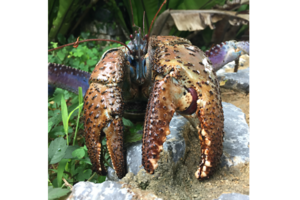Could this crab have the most crushing claws?
You might not want to get caught in the claws of the hermit crab's big, scary cousin: the coconut crab.

This is a coconut crab (Birgus latro) that weights about 4.4 lbs.
Courtesy of Shin-ichoro Oka
The enormous claws of a coconut crab may be more powerful than they look – and they look pretty scary.
The crab native to islands in the Indian and Pacific Oceans can grow up to a leg-span of 3 feet and a weight of nearly 9 pounds, making it the largest terrestrial crab. Being such massive animals, coconut crabs (Birgus latro) try to eat whatever they can get their burly claws on. While that mostly means vegetation like the hard-shelled coconut for which they are named, they are also know to prey on other small animals like kittens.
Anyone who has ever tried to crack open a coconut without tools knows this is quite the feat, even for a 9-pound crab. So a team of scientists decided to measure exactly how much force these hefty crustaceans can exert when they pinch their prey.
As it turns out, the coconut crab's claw can pinch with a force greater than that of any other crustacean that has been measured, according to a paper published Wednesday in the journal PLOS ONE.
The 9-pound crustacean could exert a force of up to 3,300 newtons, according to the new research. That's more than 4.5 times as forceful as the grip strength of most humans.
As for the top land-dwelling predators, crocodiles top the crabs with bite forces of about 16,460 newtons. But the crabs come closer to hyenas, lions, and tigers, which snap their jaws shut with a force of about 4,450 newtons. (It is important to note that the coconut crabs do not snap their pinchers shut like the big cats' jaws. It's more of a crushing force than a sudden snap.)
"We expected the force would be very strong. But the actual powers exceeded our expectation," study lead author Shin-ichiro Oka, a chief researcher at the Okinawa Churashima Foundation in Japan, writes in an email to The Christian Science Monitor.
"And we were also surprised that their pinching force was approximately 90 times of their body weight," he says. If he himself were a coconut crab, Mr. Oka points out, at about 145 pounds, he could crush something with about 6 tons of force.
So what is behind these massive pinching forces?
"One of the things that crabs have is a very large concentration of muscle fibers that have a unique property, being exceptionally long sarcomeres," Graeme Taylor, a biologist at Western University in Canada who studies animal biomechanics but was not part of the coconut crab study, explains in a phone interview with the Monitor. Sarcomeres are a component in skeletal muscles that make it able to contract, so by having especially long sarcomeres, he says, "what that enables the crabs to do, in fact, is be able to produce a quite large force per unit area of muscle."
Calculations suggested that coconut crabs' sarcomeres should have been particularly long for the animal's strength. But when the researchers measured the coconut crab's sarcomeres, they weren't even close to how long they should have been (although they were still significantly longer than those in species other than crabs). So the researchers say there must be other morphological characteristics behind the powerful pinchers.
The researchers suggest that coconut crabs may have evolved such forceful claws as they adapted to their terrestrial lifestyle. As cousins of hermit crabs, coconut crabs start out life in a shell shelter, but as they become adults they shed the shell, and develop harder and bigger bodies. The crabs also often physically fight over resources, so such hefty claws serve as powerful weapons.
"Their mighty claws also allow them to be active predators by facilitating effective hunting and feeding on other terrestrial organisms with hard exteriors, thereby aiding in the maintenance of their large body size," the researchers write in their paper. "In particular, the ability of these crabs to open coconuts demonstrates the impressive force of their claws."
Approaching these crabs in the wild and getting them to clamp their claws down on force-sensing devices proved tricky. As the researchers write, "During our field study, obtaining data for analysis was challenging, as the large claws of this crab pinched us on multiple occasions."
So, if you ever have to name a coconut crab, Charlie might be a good fit.

